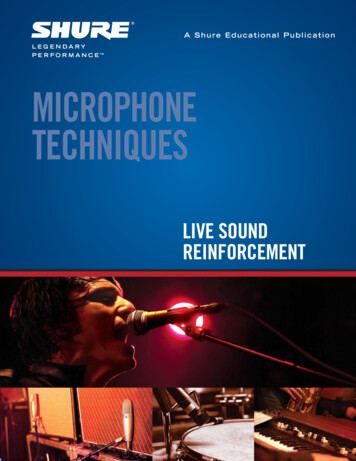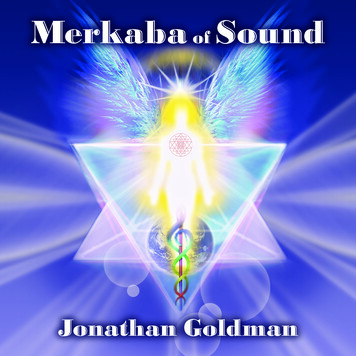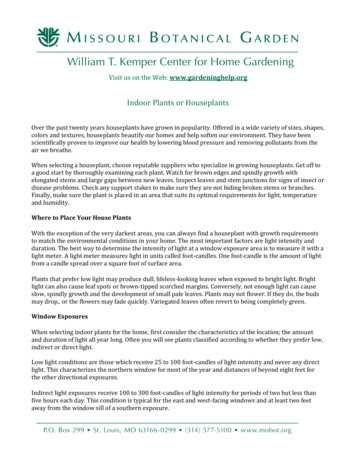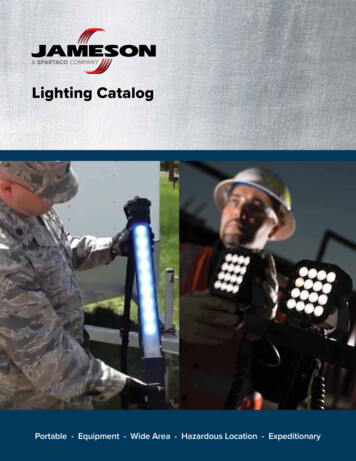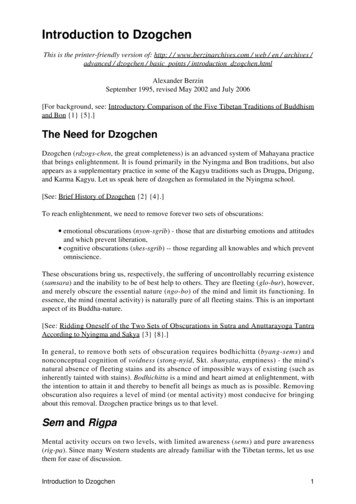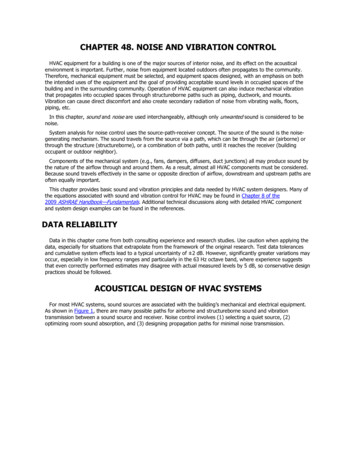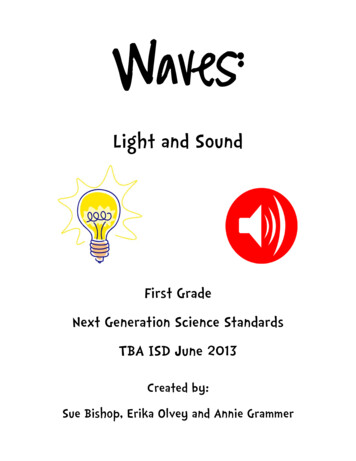
Transcription
Waves:Light and SoundFirst GradeNext Generation Science StandardsTBA ISD June 2013Created by:Sue Bishop, Erika Olvey and Annie Grammer
Teacher Introduction to Waves: Light and SoundDuring the study of light and sound waves students will develop their science skillsthrough inquiry, prediction, observation, exploration, discussion and recording. These lessonsfocus on students collaboratively problem solving, discovering and investigating to find answersand solutions. They will answer questions such as; What happens when materials vibrate?What objects can be used to communicate over a distance? What happens when light isblocked or when materials of different kinds are placed in the path of a beam of light? Eachlesson includes science and engineering practices, disciplinary core ideas and crosscuttingconcepts which are a part of Next Generation Science Standards.These lessons were designed to allow students to make their own predictions andobservations while testing and recording their findings. Our lessons were planned using the 5-ELearning Cycle Model. Each lesson is broken down into the following categories; Engage,Explore, Explain, Extend and Evaluate. We also chose to break the lessons into sessions. Somelessons may take 1-2 thirty minute sessions. We included suggestions as to how we wouldbreak those lessons; please use these lessons as they fit into your schedule. Each lessoncontains pertinent information to assure that all of the standards are addressed.Student journal pages are included after each lesson. There are 3 performanceassessments included in the student journal. Make sure to keep the student journals untilthose have been recorded on the final assessment page.
1.Waves: Light and Sound1.Waves: Light and SoundStudents who demonstrate understanding can:1-PS4-1. Plan and conduct investigations to provide evidence that vibrating materials can make sound and that sound canmake materials vibrate. [Clarification Statement: Examples of vibrating materials that make sound could include tuning forks and plucking a stretchedstring. Examples of how sound can make matter vibrate could include holding a piece of paper near a speaker making sound and holding an object near a vibratingtuning fork.]1-PS4-2. Make observations to construct an evidence-based account that objects can be seen only when illuminated.[Clarification Statement: Examples of observations could include those made in a completely dark room, a pinhole box, and a video of a cave explorer with a flashlight.Illumination could be from an external light source or by an object giving off its own light.]1-PS4-3. Plan and conduct an investigation to determine the effect of placing objects made with different materials in thepath of a beam of light. [Clarification Statement: Examples of materials could include those that are transparent (such as clear plastic), translucent (such aswax paper), opaque (such as cardboard), and reflective (such as a mirror).] [Assessment Boundary: Assessment does not include the speed of light.]1-PS4-4. Use tools and materials to design and build a device that uses light or sound to solve the problem ofcommunicating over a distance.* [Clarification Statement: Examples of devices could include a light source to send signals, paper cup and string“telephones,” and a pattern of drum beats.] [Assessment Boundary: Assessment does not include technological details for how communication devices work.]The performance expectations above were developed using the following elements from the NRC document A Framework for K-12 Science Education:Science and Engineering PracticesDisciplinary Core IdeasPlanning and Carrying Out InvestigationsPlanning and carrying out investigations to answer questions ortest solutions to problems in K–2 builds on prior experiencesand progresses to simple investigations, based on fair tests,which provide data to support explanations or design solutions. Plan and conduct investigations collaboratively to producedata to serve as the basis for evidence to answer aquestion. (1-PS4-1),(1-PS4-3)Constructing Explanations and Designing SolutionsConstructing explanations and designing solutions in K–2 buildson prior experiences and progresses to the use of evidenceand ideas in constructing evidence-based accounts of naturalphenomena and designing solutions. Make observations (firsthand or from media) to constructan evidence-based account for natural phenomena (1-PS42) Use tools and materials provided to design a device thatsolves a specific problem. (1-PS4-4)PS4.A: Wave Properties Sound can make matter vibrate, and vibrating matter canmake sound. (1-PS4-1)PS4.B: Electromagnetic Radiation Objects can be seen if light is available to illuminate themor if they give off their own light. (1-PS4-2) Some materials allow light to pass through them, othersallow only some light through and others block all thelight and create a dark shadow on any surface beyondthem, where the light cannot reach. Mirrors can be usedto redirect a light beam. (Boundary: The idea that lighttravels from place to place is developed throughexperiences with light sources, mirrors, and shadows, butno attempt is made to discuss the speed of light.) (1PS4-3)PS4.C: Information Technologies andInstrumentation People also use a variety of devices to communicate(send and receive information) over long distances. --------------Connections to Nature of ScienceCrosscutting ConceptsCause and Effect Simple tests can be designed to gatherevidence to support or refute student ideasabout causes. ----------------------------Connections to Engineering, Technology,and Applications of ScienceInfluence of Engineering, Technology, andScience, on Society and the Natural World People depend on various technologies in theirlives; human life would be very differentwithout technology. (1-PS4-4)Scientific Investigations Use a Variety of Methods Science investigations begin with a question. (1-PS4-1) Scientists use different ways to study the world. (1-PS4-1)Connections to other DCIs in first grade: N/AArticulation of DCIs across grade-levels: K.ETS1.A (1-PS4-4); 2.PS1.A (1-PS4-3); 2.ETS1.B (1-PS4-4); 4.PS4.C (1-PS4-4); 4.PS4.B (1-PS4-2); 4.ETS1.A (1-PS4-4)Common Core State Standards Connections:ELA/Literacy –Write informative/explanatory texts in which they name a topic, supply some facts about the topic, and provide some sense of closure. (1-PS4-2)Participate in shared research and writing projects (e.g., explore a number of “how-to” books on a given topic and use them to write a sequence of instructions). (1-PS41),(1-PS4-2),(1-PS4-3),(1-PS4-4)With guidance and support from adults, recall information from experiences or gather information from provided sources to answer a question. (1-PS4-1),(1-PS4-2),(1PS4-3)Participate in collaborative conversations with diverse partners about grade 1 topics and texts with peers and adults in small and larger groups. atics –MP.51.MD.A.11.MD.A.2PS4-3)Use appropriate tools strategically. (1-PS4-4)Order three objects by length; compare the lengths of two objects indirectly by using a third object. (1-PS4-4)Express the length of an object as a whole number of length units, by layering multiple copies of a shorter object (the length unit) end to end; understand that thelength measurement of an object is the number of same-size length units that span it with no gaps or overlaps. (1-PS4-4)*The performance expectations marked with an asterisk integrate traditional science content with engineering through a Practice or Disciplinary Core Idea.The section entitled “Disciplinary Core Ideas” is reproduced verbatim from A Framework for K-12 Science Education: Practices, Cross-Cutting Concepts, and Core Ideas. Integratedand reprinted with permission from the National Academy of Sciences.May 2013NGSS Release9
Dear Family,Our class is starting to learn about sound and light. My teacher said we’re going to be exploringand experimenting with a lot of fun stuff. We get to be scientists!These are the main ideas of our unit.- Sounds are made when something vibrates- Sounds can be loud or soft and high or low- We use sound and light to communicate- A shadow is made when something blocks the light.These are a few of our new vocabulary words.- Translucent- Transparent- Opaque- Reflective- Illumination- Vibration- CommunicationHere are a few fun ways you can help me at home.- We can put out different sized cooking pans and use spoons to tap on them to hear different sounds.- We can use a few of the same size drinking glasses and fill them with different amounts of water.Then we lightly tap on them and listen to the different sounds they make.- Using a flashlight or lamp we can shine it against a blank wall and put different objects in front of itto make shadows.There are also a couple of good books that we can get from the library.ZIN! ZIN! ZIN! A Violin by Lloyd MossWhat Makes a Shadow? by Clyde Robert BullaOne more thing. . . I need to bring a toilet paper tube for one of our first activities.Thanks for helping me be a great student!
Lesson 1*Focus: 5 SensesLength: 1- 30 minute sessionMaterials:-My Five Senses by AlikiStudent Journal cover and pg. 1Student Grouping/Class Set Up: Whole GroupEngage: Read the book My Five Senses aloud to the class. Then explain that they will complete thestudent journal page. They need to draw and label two examples of each of the five senses.Explore: As students finish their first journal page they can discuss their drawings and explore thejournal with their friends.Explain: After the kids explore their journals, see if they can tell you what 2 senses we will be focusingon. Discuss where light and sound come from and then they can do the front cover of the journal.* This lesson is optional and can be used to introduce or review the 5 senses if you think your studentsneed it. If not, please continue to the next lesson.
NameDraw pictures of things that makelight or sound.Student JournalFirst Grade- Waves: Light and Sound
Draw two pictures to go with each of the 5 senses.1
Lesson 2: The Listening WalkLength: 1- 30/40 minute sessionMaterials:The Listening Walk by Paul ShowersAll About Sound by Lisa TrumbauerLarge piece of paper for anchor chartStudent Journal pages 2 & 3Performance Expectations: 1-PS4-1. Plan and conduct investigations to provide evidence that vibrating materials canmake sound and that sound can make materials vibrate.Student Grouping/Class Set Up: Whole GroupEngage: What sounds can we hear in our school? Record answers on anchor chart with the whole group. Read the bookListening Walk and add any other ideas the students may have after listening to the book.Explore: Introduce the Listening Walk (student journal page 2). With a partner the students will walk around the schoollistening for the sounds on the chart. When they hear a sound they will color the appropriate box. If they hear a soundthat is not on the chart they can add it in one of the blank boxes.Explain: When the class returns from the listening walk, have partners report their findings to the class. Add newsounds to the anchor chart if necessary.Elaborate: Read the book All About Sound and discuss any new words they heard, especially vibration. Introduce theSound Song (student journal page 3) and sing it a couple of times.Evaluate: Keep the student journals so that observations can be made at the end of the unit.Science & Engineering Practices:Disciplinary Core Ideas:Crosscutting Concepts: PS4.A: Wave PropertiesSound can make matter vibrate,and vibrating matter can makesound. (1-PS4-1) Asking questions (science) and definingproblems (engineering)Developing and using modelsPlanning and carrying outinvestigationsAnalyzing and interpreting dataUsing mathematics and computationalthinkingConstructing explanations (science)and designing solutions (engineering)Engaging in argument from evidenceObtaining, evaluating, andcommunicating information PatternsCause and effect: Mechanism andexplanationScale, proportion, and quantitySystems and system modelsEnergy and matter: Flows, cycles, andconservationStructure and functionStability and change
to the tune of “London Bridge”Sound is made of vibrations,vibrations, vibrationsSound is made of vibrations,hmmm, hmmm, hmmm, hmmm.(place hand on throat to feel vibration)Pitch is either high or low,high or low, high or low,Pitch is either high or low,high or low.(Up on tippy-toes, then down to the floor)Volume means it’s loud or soft,loud or soft, loud or soft,Volume means it’s loud or soft,loud or soft.(LOUD is said loudly, soft is said softly)Sound is made of vibrations,vibration, vibrationsSound is made of vibrations,hmmm, hmmm, hmmm, hmmm.(place hand on throat to feel vibration)
The Listening WalkListen carefully for each of these sounds.Color a square for each of the sounds you laughingloudspeaker
Lesson 3: What’s the Buzz!Length: 1- 30/40 minute sessionPerformance Expectations: Make and use a kazoo to discover how vibrations create sound waves that travel throughthe air to your ear. Plan and conduct investigations to provide evidence that vibrating materials can make sound andthat sound can make materials vibrate. (Standard 1-PS4-1)Materials:-Toilet paper tubes (from home per parent letter) with small holes precutwaxed paper (cut into 4X4 squares)aluminum foil (cut into 4x4 squares)plastic wrap (cut into 4x4 squares)rubber bandsStudent Grouping/Class Set Up: Partners to help with creating the kazoo. Each student makes their own kazoo.Engage: Today we will make an instrument that anyone can play and get the buzz on sound vibrations. Vibrationscreate sound waves that travel through the air. Have you ever tossed a pebble or stone into the lake or a pool? Did younotice the waves created by your stone? Sound waves travel through the air kind of like the circle of ripples created bytossing a stone into the water. Today we are going to make a Kazoo to investigate vibrations that cause sound wave.Explore: Students will make a kazoo and experiment with different kinds of sounds to see what causes the loudestbuzzing.Explain: See attached page for directions (What’s the Buzz?)Elaborate: Play it! Place the open end of the kazoo lightly over your mouth and say AHHH! What happens? Now sing orhum a tune into it. Try making different kinds of sound to see what causes the loudest buzzing.Extensions: Touch the waxed paper with your finger while you play your Kazoo. What do you notice? Now cover thehole with your finger while you play the Kazoo. What happens? Does the hole make it easier or harder to play? Why?Evaluate: Whole group discussion to determine if students have understood the concept thatVibrations cause sound waves that our ears convert into noise or voices.Extension Activity: Make more Kazoos, changing one thing (called a variable). Try using tin foil or plastic wrap instead ofwaxed paper. Does it change anything? Make a prediction which material you think will make the loudest/quietistsound. Test it out and then check your predictions.Science & Engineering Practices:Disciplinary Core Ideas:Crosscutting Concepts: PS4-A: Wave PropertiesSound can make matter vibrateand vibrating matter can makesound. (1-PS4-1 Asking questions (science) and definingproblems (engineering)Developing and using modelsPlanning and carrying outinvestigationsAnalyzing and interpreting dataUsing mathematics and computationalthinkingConstructing explanations (science)and designing solutions (engineering)Engaging in argument from evidenceObtaining, evaluating, andcommunicating information PatternsCause and effect: Mechanism andexplanationScale, proportion, and quantitySystems and system modelsEnergy and matter: Flows, cycles, andconservationStructure and functionStability and change
Activity SheetWhat’s the Buzz?Make an instrument that anyone can play—a kazoo—and get the buzz on sound vibrations!1Get what you need.2 Make a kazoo. Use a pencil to make a small hole about twoinches from one end of the cardboard tube. Cut a square of waxed paper that’s an inch ortwo wider than the end of the tube.4 Experiment. Touch the waxed paper with your finger whileyou play the kazoo. What do you notice? Cover the hole with your finger while you playthe kazoo. What happens? Does the hole makeit easier or harder to play it? Why? Make more kazoos, changing one thing (calleda variable). Instead of waxed paper, try tin foilor plastic wrap. Predict which material youthink will make the best sound. Test it out.Were your predictions right?Chew on This!All sound is made up of vibrations(rapid back-and-forth movement),which produce sound waves thattravel through the air to our ears.When you play a kazoo, air carriesthe sound waves from your mouthdown the tube, making the waxedpaper vibrate. You can feel thosevibrations if you touch thewaxed paper.TM/ 2009 WGBH Educational Foundation. toilet paper tubes waxed paper aluminumfoil plastic wrap rubber bands scissors sharpened pencil plastic comb (optional—for Dig Deeper activity on back of sheet) Wrap the waxed paper tightly over the end ofthe tube where you made the hole. Hold it inplace with a rubber band, making sure youdon’t cover the hole you made. Trim off anyexcess waxed paper with scissors.3 Play it!Place the open end of the kazoo lightly overyour mouth and say, “AAHHH!” What happens?Now sing or hum a tune into it. Try makingdifferent kinds of sounds to see what causesthe loudest buzzing.tin foilwaxed paper9
Lesson 4: Making a Splash and Musical RulersLength: 2- 30 minute sessionsPerformance Expectations: Plan and conduct investigations to provide evidence that vibrating materials can makesound and that sound can make materials vibrate. (Standard 1-PS4-1) Students will observe simple objects, patterns andevents and report their observations in a simple graph.Background: All sound it made up of vibrations which produce sound waves that travel through the air to our ears.Vibrating matter can make sound and sound makes matter vibrate causing sound waves to travel through the air.Materials:- tuning forks- bowl of water- 12 inch plastic rulersStudent Grouping/Class Set Up: Split students into 2 groups (1 adult with each group if possible)Engage: Today we will experiment with a musical tool called a tuning fork. Prompt students with prior knowledgequestions and let them practice using the tuning forks and rulers in an appropriate way. They need to be in 2 groups(Suggestion- 1 group will do “Making a Splash” one day and “Magical Rulers” the next day.)Explore:Group #1: Put the bowl of water on a surface where students will be able to make observations. With one of the tuningforks, hit it so it vibrates. Quickly put it in the water and observe what it does. How far did the water splash? Try thesame thing with each tuning fork. Using the Making a Splash (student journal page 4) observe patterns, cause and effectand record observations.Group #2: Using a 12 inch plastic ruler observe the difference in the sounds when the ruler is extended over the table atdifferent lengths. Put the ruler at the edge of the table so half of it hangs over the edge. Hold the ruler down with thepalm of one hand on the table. With your other hand push the end of the ruler down and let it go. Observe thevibrations of your ruler and the sound it makes. Write your observations on Musical Rulers (student journal page Keepdoing this until you can’t press it down any more each time recording your results on your chart.Elaborate: Compare your observations with a classmate.Evaluate: Whole group discussion to determine if students have understood the concept that vibrations cause soundwaves that our ears convert into noise or voices. Use attached discussion questions to lead and review of the similaritiesand differences that were observed with each experiment.Science & Engineering Practices:Disciplinary Core Ideas:Crosscutting Concepts: PS4-A: Wave PropertiesSound can make matter vibrateand vibrating matter can makesound. (1-PS4-1) Asking questions (science) and definingproblems (engineering)Developing and using modelsPlanning and carrying outinvestigationsAnalyzing and interpreting dataUsing mathematics and computationalthinkingConstructing explanations (science)and designing solutions (engineering)Engaging in argument from evidenceObtaining, evaluating, andcommunicating information PatternsCause and effect: Mechanism andexplanationScale, proportion, and quantitySystems and system modelsEnergy and matter: Flows, cycles, andconservationStructure and functionStability and change
Discussion Questions for Making a Splash:What did you observe each time you put a tuning fork in the bowl of water?What are some similarities that you noticed with the tuning forks?What are some differences that you noticed with the tuning forks?Why do you think there were changes between the tuning forks?What conclusions can you make about this exploration?Discussion Questions for Musical Rulers:What did you observe each time you moved the ruler?What are some similarities in sound that you noticed?What are some differences in sound that you noticed?Why do you think there were changes each time you moved the ruler?What conclusions can you make about this exploration?
Making a SplashMaterials:- Tuning Fork labeled A, B, C- Bowl of water- Colored piece of paperProcedure:1. Put the bowl of water on a colored piece of paper.2. With one of the tuning forks, hit it so it vibrated. Quickly put it in the water. Observewhat it does. Measure how far the water splashes.3. Repeat #2 with each tuning fork and record observations C4
Musical RulersMaterials:- Plastic Ruler marked 1, 2, 3Procedure:1. Put the plastic ruler on the table so that the edge is lined up with the first mark onthe ruler.2. Holding the ruler against the table with one hand, push the other side down gentlyand let go. Feel the vibration? Hear the music?3. Observe the vibration and sound the ruler is making and record your observationsbelow.4. Repeat for the 2nd and 3rd mark on the ruler and record Mark35
Lesson 5: Cup-a-PhoneLength: 2- 30/40 minute sessionsPerformance Expectations:1-PS4-1. Plan and conduct investigations to provide evidence that vibrating materials can make sound and that soundcan make materials vibrate.1-PS4-4. Use tools and materials to design and build a device that uses light or sound to solve the problem ofcommunicating over a distance.Materials:-Paper cups and Styrofoam cupsCotton string (precut into 36 inch pieces)Fishing line- bar of soap- paper clips- scissorsStudent Grouping/Class Set Up: Whole Group and Partner GroupsEngage: Draw a giant web on an anchor chart and write “Communication” in the middle. Ask students for examples ofhow people can communicate. Examples: calling, texting, sign language, Morse code, social media, light signals, yelling,school bells, barking, movement. (Keep this web for a lesson and journal page later in the unit) Students will then beguided through the making of a cup-a-phone.Directions: Give each student 1 piece of cotton string and 2 paper cups. The students need to poke a hole in thebottom of their cup with their pencil and put the string through it. Then they need to tie a paper clip to the endof the sting inside the cup. Repeat for the other cup.Explore: Students need to collaborate with a partner to try out their phones. Let them explore and come up with theanswers about how the phones work. Some students may need to go in the hallway to hear each other.Explain: After students have had a chance to explore with their paper cup-a-phone bring them together as a wholegroup and discuss what made it possible for them to hear each other. Key idea: vibrating materials make sound andsound can make materials vibrate.Engage/Explore/Evaluate: (Suggestion- 2nd 30-40 minute session) Students are now going to use different materials todesign and build a device that allows them to communicate over a distance. They are going to make another phone butneed to make their own decisions on materials and record their observations. It’s time for them to be scientists!Directions: Using “I’m a Scientist” (student journal page 6) to guide them, students need to make another cup-aphone. They will choose one variable; string length, Styrofoam cup or fishing line. Encourage them to only have1 variable. Then they will make a hypothesis, record their observations and evidence and come to a conclusion.This is going to be used as an assessment so try not to guide students but let them explore and come to theirown conclusions.Evaluate: On the back of student journal page 6 record assessment data.Science & Engineering Practices: Asking questions (science) and definingproblems (engineering)Developing and using modelsPlanning and carrying outinvestigationsAnalyzing and interpreting dataDisciplinary Core Ideas:matter vibrate, and vibrating matter canmake sound. (1-PS4-1)PS4.C: Information Technologies andof devices to communicate (send andCrosscutting Concepts: PatternsCause and effect: Mechanism andexplanationScale, proportion, and quantitySystems and system modelsEnergy and matter: Flows, cycles, andconservation
Using mathematics and computationalthinkingConstructing explanations (science)and designing solutions (engineering)Engaging in argument from evidenceObtaining, evaluating, andcommunicating informationreceive information) over long distances.(1- PS4-4) Structure and functionStability and change
I’m a Scientist!Circle the variable you used:Styrofoam cupsFishing LineString lengthDraw a picture of your device:How will this be different than the model we built?Draw or explain what you observedDid your new device make a vibration?YesNoCould you hear the vibration?YesNo6
Performance AssessmentVariable Circled and Used/ 1Picture of device/ 1How will this be different/ 1Draw/Explain Observations/ 1Yes circled/ 1Yes circled/ 1Total/ 6
Lesson 6: In the Dark!Length: 1- 30/40 minute sessionPerformance Expectations:1-PS4-2. Make observations to construct an evidence-based account that objects can be seen only when illuminated.Materials:-All About Light by Lisa TrumbauerPinhole boxesSmall figurineFlashlightsStudent Journal pages 7 & 8Student Grouping/Class Set Up: Partner work and individual workEngage: Pose a problem about being in a dark room with a friend. The room does not have windows and the lights wentout. Think about what you could use in order to be able to see your friend in the darkness.Explore: Have students use student journal page 7 to brainstorm ideas using pictures with labels. The students willshare their ideas with the class. Were there any ideas you didn’t have in your journal?Explain: Explain that in order to see objects we need light. Read the book All About Light aloud to the class.Elaborate: Working with a partner, the students will use the pinhole boxes to observe that objects need light to be seen.They will record findings and explanations on student journal page 8. Circulate the room as students explore with thepinhole boxes. Verify that they understand the concept that objects can only be seen when they are illuminated.Directions:1- They need to look through into the closed dark pinhole box. Can they see the object?2- Open the top of the box. Can they see the object?3- Shine a flashlight into the pinhole box through the hole. Can they see the object?Evaluate: Student journal page 8 “Can you see it?” Follow up with class discussion of findings.Science & Engineering Practices:Disciplinary Core Ideas:Crosscutting Concepts: Objects can be seen if light is available toilluminate them or if they give off theirown light. (1-PS4-2) Asking questions (science) and definingproblems (engineering)Developing and using modelsPlanning and carrying outinvestigationsAnalyzing and interpreting dataUsing mathematics and computationalthinkingConstructing explanations (science)and designing solutions (engineering)Engaging in argument from evidenceObtaining, evaluating, andcommunicating information PatternsCause and effect: Mechanism andexplanationScale, proportion, and quantitySystems and system modelsEnergy and matter: Flows, cycles, andconservationStructure and functionStability and change
In the DarkYou and your friend are in a room with no windows. The lights goout! What are some things you could use to be able to see eachother?Draw your ideas below. Don’t forget to label them.
Can You See it?When you look in the pinhole box, can you see the object?Record your findings. Explain your thinking.Look in the hole of the closed box.Can you see the object?YES NOExplain why or why notShine a flashlight in the hole of the closed box.Can you see the object? YESNOExplain why or why notOpen the lid of the box. Look in the hole of the box.Can you see the object? YESNOExplain why or why not
Lesson 7: What’s that Glow?Length: 1- 30/40 minute sessionPerformance Expectations:1-PS4-2. Make observations to construct an evidence-based account that objects can be seen only when illuminated.Materials:FlashlightsGlow sticks and glow braceletsPaper bagFireflies by Julie BrinckloeStudent Grouping/Class Set Up: Whole GroupEngage: Put the flashlight and glow sticks in a paper bag so the kids can’t see them yet. Start by setting the scene forkids. Let’s pretend we’re going on a camping trip in the deep woods. When night come it gets very dark. What couldwe use to help us see in the dark? Get the flashlight out of the bag and discuss how a flashlight illuminates and provideslight. Ask if there is something else
light and create a dark shadow on any surface beyond them, where the light cannot reach. Mirrors can be used to redirect a light beam. (Boundary: The idea that light travels from place to place is developed through experiences with light sources, mirrors, and shadows, but no attempt is made t

